Chamomile and Lavender for Dissociative Anxiety Relief
Introduction
When anxiety and dissociation intertwine, the experience can feel surreal — like your body is vibrating while your mind floats somewhere far away. You may feel both hyperalert and disconnected at the same time: your heart races, but your thoughts feel foggy; you want to ground yourself, but your nervous system won’t let you.
This state isn’t “just in your head.” It’s the result of a dysregulated nervous system, often triggered by trauma or prolonged stress. The brain’s alarm systems — especially the amygdala and hypothalamus — remain overactive, flooding the body with adrenaline and cortisol. In response, the mind sometimes detaches to protect you from overwhelm.
That mix of anxious energy and emotional distance is what makes dissociative anxiety so challenging. But nature provides gentle allies that can help restore calm without forcing alertness or sedation: chamomile and lavender.
These two botanicals have been used for centuries to quiet the nervous system, relieve anxiety, and promote emotional reconnection. Modern research confirms what herbalists long knew — that they can reduce cortisol, regulate GABA activity, and support the parasympathetic (“rest and digest”) state that allows the mind and body to rejoin peacefully.
This article explores how chamomile and lavender support dissociative anxiety relief through neurochemical, hormonal, and sensory pathways 🌙.
Looking for supplements for This? Click here.
Understanding Dissociative Anxiety 🌫️
Anxiety and dissociation are often seen as opposites — one hyperaroused, the other shut down — yet they can coexist in a single moment.
When the nervous system senses danger, it first activates the sympathetic response — fast heartbeat, rapid breathing, muscle tension. If the threat persists or feels inescapable, the system flips into dorsal vagal shutdown, a freeze state marked by emotional numbness and detachment.
In dissociative anxiety, both states flicker back and forth. You may feel panicked one second and blank the next, flooded with adrenaline yet disconnected from your surroundings.
This dysregulation leaves you stuck between fight-or-flight and freeze. Your vagus nerve, which helps shift the body back into calm, struggles to regain control.
Chamomile and lavender work beautifully here because they calm the sympathetic system and activate the parasympathetic one — helping the body rediscover equilibrium.
The Biology of Calm: Why Nature Helps 🌿

Your brain chemistry during dissociation often includes low GABA (a neurotransmitter that inhibits anxiety), high cortisol, and dysregulated serotonin and dopamine.
Both chamomile and lavender influence these systems naturally. They interact with GABA receptors much like mild anti-anxiety medications do, but without dependency or sedation. They also support serotonin balance, lower cortisol, and modulate the HPA (hypothalamic-pituitary-adrenal) axis that governs the stress response.
By quieting this biochemical storm, they help restore mental clarity and emotional presence. The body stops sending constant “danger” signals, and the mind can safely come back online.
Chamomile: Nature’s Nervous System Soother 🌼
Chamomile (Matricaria recutita or Chamaemelum nobile) has long been known as one of nature’s most effective calmatives. Its name comes from the Greek for “ground apple,” a nod to its gentle, sweet scent — but its effects reach far deeper than the senses.
The active compounds in chamomile, particularly apigenin, bisabolol, and chamazulene, have strong anxiolytic (anti-anxiety) and anti-inflammatory effects.
GABA and Apigenin
Apigenin binds to GABA-A receptors in the brain — the same receptor targeted by many anti-anxiety medications. This increases inhibitory signaling, slowing overactive neural firing and inducing calm. Unlike pharmaceuticals, chamomile doesn’t sedate; it stabilizes, helping you feel relaxed but alert.
Cortisol Regulation
Studies show that chamomile reduces cortisol and supports healthy adrenal rhythms. By calming the stress-hormone loop, it helps prevent the oscillation between anxiety and numbness characteristic of dissociative states.
Inflammation and Gut-Brain Relief
Chamomile also soothes the gut, which plays a key role in emotional regulation. Because 90% of serotonin is produced in the intestines, reducing gut inflammation indirectly stabilizes mood and awareness.
Chamomile tea or extract can thus ease both digestive tension and emotional disconnection — supporting healing from the inside out.
Lavender: The Fragrance of Emotional Reconnection 💜
Lavender (Lavandula angustifolia) is best known for its scent, but its effects go far beyond aromatherapy. It directly influences the limbic system, the emotional center of the brain, through both inhalation and ingestion.
Lavender’s active constituents — linalool and linalyl acetate — interact with serotonin and GABA pathways, creating relaxation without drowsiness.
Modulating the Limbic System
When you inhale lavender essential oil, its molecules travel through the olfactory nerve to the amygdala and hippocampus — brain regions heavily involved in trauma and memory. This is why scent can evoke emotions so powerfully.
Lavender helps calm amygdala overactivity, reducing fear and hypervigilance while promoting emotional openness.
Vagus Nerve Activation
Lavender’s aroma also triggers parasympathetic activation via the vagus nerve, slowing heart rate and deepening breathing. Over time, this strengthens vagal tone — a key factor in emotional regulation and trauma recovery.
Sleep and Recovery
Poor sleep amplifies anxiety and dissociation. Lavender enhances slow-wave sleep by increasing alpha brain waves, allowing the mind to process emotions and memories more efficiently during rest.
Together, these effects make lavender one of the most powerful botanical tools for nervous system healing.
The Science Behind the Calm 🧠
Modern studies back what ancient traditions already knew: both chamomile and lavender exert measurable effects on the nervous system.
A 2016 Phytomedicine trial found that standardized chamomile extract significantly reduced moderate-to-severe anxiety comparable to pharmaceutical anxiolytics, without side effects.
A 2013 Frontiers in Pharmacology study showed lavender oil (Silexan) decreased generalized anxiety symptoms, lowered cortisol, and improved sleep quality.
Neuroimaging research revealed that inhaling lavender reduces amygdala activation while increasing activity in the prefrontal cortex — the part of the brain responsible for rational thought and self-awareness, both impaired in dissociation.
By combining biochemical modulation and sensory grounding, these herbs support both the mind’s chemistry and the body’s sense of safety — exactly what dissociative anxiety needs.
Why Smell Heals: Aromatherapy and Memory 🌬️
Scent is the only sensory input that bypasses the brain’s thalamus and connects directly to the limbic system, where emotions and memories live. This is why certain smells can instantly calm you or transport you to a moment in time.
For people with dissociation, this sensory pathway can help anchor presence. Smelling lavender or chamomile essential oils activates the amygdala and hippocampus in a way that gently reawakens emotional processing — without triggering overwhelm.
Using these scents during grounding exercises, meditation, or therapy sessions can help bridge the gap between mind and body, creating a sensory cue that signals safety and calm.
How Chamomile and Lavender Work Together 🌿💜
Chamomile and lavender complement each other perfectly. Chamomile primarily works through GABAergic and anti-inflammatory pathways, while lavender acts more on serotonin and limbic regulation.
Chamomile soothes the body’s stress response and digestive tension. Lavender quiets emotional hyperarousal and reconnects sensory awareness.
Together, they balance two halves of the nervous system: one chemical, one emotional. This synergy promotes deep calm, gentle awareness, and reduced anxiety — without numbing.
Over time, this blend can help retrain the nervous system to remain regulated even under stress.
Practical Ways to Use Them 🌙
Chamomile Tea Ritual
A warm cup of chamomile tea can become a grounding practice. Sip slowly, breathe in the aroma, and feel warmth spread through your body. Each sip signals your system to shift toward safety.
Lavender Aromatherapy
Diffuse lavender essential oil during rest, meditation, or before sleep. You can also rub a drop (diluted in carrier oil) onto your wrists or the back of your neck, then inhale deeply to activate vagal calm.
Combined Evening Routine
Drink chamomile tea while diffusing lavender oil or applying lavender balm to your temples. This dual sensory approach engages taste, smell, and touch — three grounding senses that pull you back into your body.
Bath or Foot Soak
Add chamomile flowers and a few drops of lavender oil to warm water. Immersion enhances parasympathetic activation and lowers cortisol levels.
These simple rituals create consistent cues of calm, helping the nervous system re-learn safety through repetition.
The Gut–Brain Angle: Why Calm Starts in the Stomach 🌾
Chamomile’s soothing effects on digestion aren’t just physical. The gut and brain share a two-way communication channel — the gut-brain axis — mediated by the vagus nerve and gut bacteria.
When stress disrupts digestion, inflammatory molecules travel from the gut to the brain, amplifying anxiety and mental fog. Chamomile reduces intestinal inflammation, balances gut flora, and promotes serotonin production in the gut lining.
A calmer gut means fewer stress signals traveling upward, allowing the brain to relax. Pairing chamomile with a healthy diet and probiotics strengthens this effect, creating a foundation for both emotional and physical equilibrium.
From Tension to Trust: How Calm Feels 💞
As you begin using chamomile and lavender consistently, you may notice small but powerful changes:
Your breath deepens.
Your heartbeat slows.
Your muscles soften.
Colors seem brighter.
You begin to feel safe enough to notice the world again.
These shifts may seem simple, but they’re profound. Every moment of calm teaches your body that it no longer needs to disconnect to survive. The body relearns safety; the mind relearns trust.
This is the opposite of dissociation — it’s integration.
Curiosity, Not Perfection 🌸
Healing dissociative anxiety takes patience. Some days you’ll feel grounded and others distant — that’s normal. The goal isn’t to eliminate symptoms overnight but to build new associations of calm and safety.
Every cup of chamomile, every breath of lavender, every moment of sensory awareness tells your nervous system: You’re allowed to rest. You’re allowed to feel.
Over time, these small signals accumulate, reshaping your inner world at the molecular and emotional level.
Science Meets Soul 🌿
Chamomile and lavender beautifully bridge science and soul. They act on the GABA and serotonin systems that regulate anxiety, yet they also provide sensory comfort that words can’t describe.
They don’t push or numb; they invite. They whisper to the nervous system, you can come home now.
Their gentle chemistry, combined with mindful ritual, transforms anxiety into awareness, and detachment into peace.
Looking for online therapy ? Click Here.
References
Amsterdam, J. D., et al. (2012). “Chamomile (Matricaria recutita) may have antidepressant activity in anxious depressed humans.” Alternative Therapies in Health and Medicine, 18(5): 44–49.
Keefe, J. R., et al. (2016). “Long-term chamomile therapy for generalized anxiety disorder: A randomized clinical trial.” Phytomedicine, 23(14): 1735–1742.
Kasper, S., et al. (2010). “Silexan, an orally administered lavender oil preparation, is effective in anxiety disorders.” International Journal of Neuropsychopharmacology, 13(5): 775–782.
Koulivand, P. H., et al. (2013). “Lavender and the nervous system.” Evidence-Based Complementary and Alternative Medicine, 2013: 681304.
Perry, N., & Perry, E. (2006). “Aromatherapy in the management of psychiatric disorders.” CNS Drugs, 20(4): 257–280.
Seifi, N., et al. (2019). “The effects of chamomile tea on anxiety and sleep quality: A randomized clinical trial.” Journal of Herbal Medicine, 17–18: 100283.
Gerbarg, P. L., & Brown, R. P. (2016). “Mind-body practices and vagus nerve regulation.” Annals of the New York Academy of Sciences, 1373(1): 66–77.
Lanius, R. A., et al. (2018). The Neurobiology and Treatment of Trauma-Related Dissociation. Routledge.
van der Kolk, B. A. (2014). The Body Keeps the Score. Viking.
Yamamoto, M., et al. (2017). “Neurochemical and anti-inflammatory effects of lavender oil inhalation.” Molecules, 22(7): 1145.
Related Posts
-
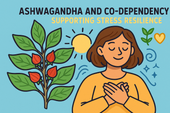
Ashwagandha and Co-Dependency: Supporting Stress Resilience
Stress is more than a feeling—it’s a full-body signal that your system is overwhelmed. When the mind races and the body tenses, your hormones, breathing, and focus all shift into survival mode. Chronic stress doesn’t just affect emotions—it reshapes your nervous system, drains your energy, and clouds your clarity. Learning to understand and manage stress gently is the first step toward peace, balance, and true recovery. 🌿💫
-
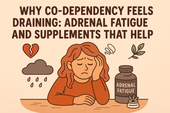
Why Co-Dependency Feels Draining: Adrenal Fatigue and Supplements That Help
The adrenal glands are small but powerful organs that sit above your kidneys, acting as your body’s built-in stress managers. They produce hormones like cortisol and adrenaline that help regulate energy, mood, and resilience. When they’re overworked from chronic stress or emotional exhaustion, fatigue and imbalance follow. Supporting adrenal health naturally can help restore calm, energy, and hormonal balance. 🌿⚡
-

The Link Between Anxiety, Co-Dependency, and Natural Support
Anxiety feels like living in constant alert mode—your heart races, your thoughts loop, and your body can’t find peace. It’s the nervous system’s way of preparing for danger, even when none exists. Understanding what’s happening in your mind and body is the first step toward calming the storm and restoring balance. 🌿💫
-
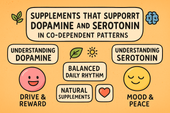
Supplements That Support Dopamine and Serotonin in Co-Dependent Patterns
Serotonin is the neurotransmitter of calm, confidence, and contentment. When it’s balanced, you feel peaceful and emotionally grounded. When it’s low, anxiety, mood swings, and emotional dependence take over. By understanding serotonin’s role in emotional health—and how to support it naturally—you can rebuild inner stability, improve relationships, and cultivate lasting happiness from within. 🌞💫
-

How Emotional Exhaustion in Codependency Impacts the Nervous System
The nervous system is the body’s communication network, connecting the brain to every organ and muscle. It regulates stress, mood, and emotion through a delicate balance of electrical and chemical signals. When overwhelmed, it can become dysregulated—leading to fatigue, anxiety, and emotional imbalance. Understanding how to calm and strengthen the nervous system is key to healing from chronic stress and emotional burnout. ⚡🌿
-
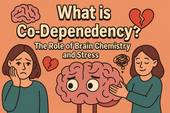
What Is Co-Dependency? The Role of Brain Chemistry and Stress
Stress is more than a feeling—it’s a full-body experience that begins in the brain and ripples through every cell. When cortisol surges and the nervous system stays on alert, your body can’t rest or recover. Over time, this constant tension affects energy, focus, mood, and even immune health. Understanding stress chemistry is the first step toward breaking free from burnout and finding calm again. 🌿
-

Creating a Supplement Stack for Motivation, Energy, and Anti-Procrastination
Motivation is the fuel behind every meaningful achievement—but it’s not just about willpower. It’s a mix of mindset, brain chemistry, and momentum. When energy, focus, and purpose align, action feels natural instead of forced. Learn how to harness motivation as a daily state, not a fleeting feeling.
-

Supplements for Building Consistency and Reducing Chronic Procrastination
Biochemistry is the bridge between biology and chemistry—the science of life at the molecular level. It explains how nutrients, hormones, and neurotransmitters interact to create energy, thought, and emotion. From brain function to muscle movement, biochemistry reveals the invisible processes that sustain health, balance, and vitality.
-
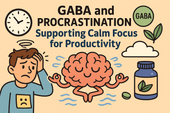
GABA and Procrastination: Supporting Calm Focus for Productivity
GABA is the brain’s natural calming messenger—a neurotransmitter that helps slow mental overactivity and ease stress. When GABA levels drop, focus fades, anxiety rises, and procrastination becomes more likely. By supporting GABA through nutrition, lifestyle, and supplements, you can restore calm clarity, improve focus, and take action with steady, balanced energy.
-
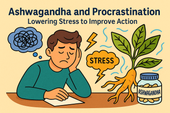
Ashwagandha and Procrastination: Lowering Stress to Improve Action
Science is the language of curiosity and discovery. It helps us understand the hidden patterns behind life, energy, and the universe. Through experimentation and critical thinking, science connects imagination to evidence—turning questions into knowledge. Whether through microscopes, molecules, or minds at work, science represents our endless pursuit of truth and innovation.
-

Neurotransmitters and Motivation: Supplements That Support Drive and Focus
Supplements can do more than boost physical health—they can also enhance mental clarity, focus, and motivation. Nutrients like omega-3s, magnesium, B vitamins, and adaptogens help balance neurotransmitters, stabilize mood, and support brain energy. When combined with good sleep, nutrition, and mindful habits, they can transform how your brain performs under stress.
-

How Stress Hormones Like Cortisol Fuel Procrastination (and What Helps)
Blood sugar isn’t just about physical health—it directly impacts focus, mood, and motivation. When glucose levels spike and crash, energy and attention do the same, fueling procrastination and brain fog. Learning how to stabilize blood sugar through balanced meals, mindful habits, and key nutrients helps keep your mind steady, focused, and ready to act.
-
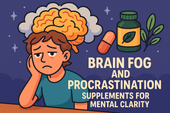
Brain Fog and Procrastination: Supplements for Mental Clarity
Brain fog can turn even simple tasks into mental hurdles. When your thoughts feel slow and unclear, procrastination often follows—making focus and productivity seem impossible. This article explores the biochemical and lifestyle causes of brain fog and reveals the most effective supplements for restoring mental clarity, focus, and sustained energy.
-

The Link Between Low Energy and Procrastination: Can Supplements Help?
Neurochemistry shapes how we think, feel, and act. When neurotransmitters like dopamine, serotonin, and GABA fall out of balance, it can lead to fatigue, anxiety, or lack of motivation—fueling procrastination and low mood. Understanding the brain’s chemical communication system helps us find ways to restore focus, calm, and emotional stability through nutrition, mindfulness, and targeted supplements.
-
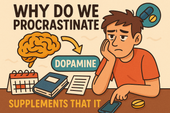
Why Do We Procrastinate? The Role of Dopamine and Supplements That Support It
Dopamine is the brain’s motivation messenger—the chemical that fuels focus, reward, and drive. When dopamine levels drop, even simple tasks can feel impossible to start. This article explores how dopamine shapes procrastination, motivation, and mental energy, along with natural supplements and daily habits that help restore balance and get things done.
-
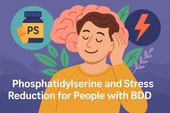
Phosphatidylserine and Stress Reduction for People with BDD
Stress is more than a mental state—it’s a full-body experience that affects hormones, brain chemistry, and emotional balance. For people with Body Dysmorphic Disorder (BDD), constant tension and worry about appearance can overload the nervous system. Learning how stress works and finding ways to calm it is key to breaking the cycle of anxiety and self-criticism.
-

How Antioxidants Like Vitamin C & E Support Mental Health in BDD
Antioxidants are the body’s natural defense against stress and inflammation. For people with Body Dysmorphic Disorder (BDD), oxidative stress can worsen fatigue, anxiety, and emotional imbalance. Nutrients like Vitamin C and E help protect brain cells, boost neurotransmitter function, and support a calmer, clearer mindset—building a stronger foundation for recovery.
-
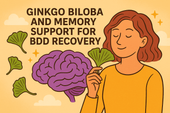
Ginkgo Biloba and Memory Support for BDD Recovery
Emotional regulation is the foundation of healing from Body Dysmorphic Disorder (BDD). When the nervous system stays in constant overdrive, even small stressors can trigger self-critical spirals. Learning to calm emotional reactivity helps restore clarity, confidence, and a sense of inner balance. By blending mindfulness, nervous system support, and self-compassion, you can retrain your brain to respond—not react—to emotion.
-

Alpha GPC and Cognitive Function in Body Dysmorphic Disorder
Mental fatigue can feel like your brain has hit a wall—thoughts slow down, focus fades, and motivation disappears. For people with Body Dysmorphic Disorder (BDD), chronic overthinking, emotional stress, and constant self-evaluation can deplete mental energy even further. Understanding what causes this cognitive exhaustion is the first step toward recovery—through rest, balanced nutrition, and targeted brain-supporting supplements.
-
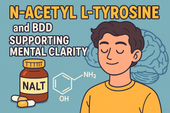
N-Acetyl L-Tyrosine and BDD: Supporting Mental Clarity
Chronic stress doesn’t just affect your mood—it reshapes your brain chemistry, weakens focus, and fuels the obsessive thought loops common in Body Dysmorphic Disorder (BDD). Over time, constant cortisol elevation drains mental energy and emotional balance. Learning to recognize and manage chronic stress is essential to restoring mental clarity, self-compassion, and resilience.
-

Chamomile and Lavender for Calming Obsessive Body Image Thoughts
The nervous system is the command center of our emotional and physical world—and in Body Dysmorphic Disorder (BDD), it often operates in overdrive. Understanding how the brain and body communicate under stress reveals why intrusive thoughts feel uncontrollable. Learning to regulate the nervous system through calm practices, nutrition, and supplements helps restore inner balance and emotional safety.
-
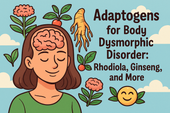
Adaptogens for Body Dysmorphic Disorder: Rhodiola, Ginseng, and More
Rhodiola rosea, often called the “golden root,” is an adaptogenic herb renowned for boosting stress resilience and mental endurance. For individuals with Body Dysmorphic Disorder (BDD), Rhodiola may help reduce fatigue, regulate cortisol, and enhance emotional balance. By supporting both mind and body, this powerful plant promotes calm focus, improved mood, and renewed energy to face daily challenges.
-
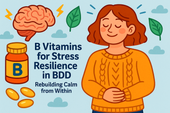
B Vitamins for Stress Resilience in BDD: Rebuilding Calm from Within
Biochemistry is at the heart of every thought, emotion, and reaction we experience. In Body Dysmorphic Disorder (BDD), chemical imbalances in neurotransmitters like serotonin, dopamine, and GABA can amplify stress and distort self-perception. Understanding the biochemistry behind mood and stress regulation offers a path toward healing—bridging the gap between emotional experience and the body’s molecular balance.
-
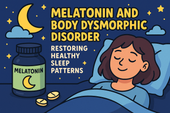
Melatonin and Body Dysmorphic Disorder: Restoring Healthy Sleep Patterns
Melatonin, the body’s natural sleep hormone, plays a vital role in helping people with Body Dysmorphic Disorder (BDD) restore healthy sleep cycles. When anxiety and obsessive thinking interfere with rest, melatonin levels often drop, leading to more emotional reactivity and distorted self-perception. This article explores how melatonin works, why BDD disrupts it, and how natural supplementation—combined with mindful routines—can help the brain and body finally find calm at night.
-
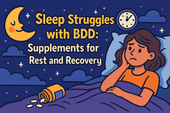
Sleep Struggles with BDD: Supplements for Rest and Recovery
When you’re living with Body Dysmorphic Disorder (BDD), restful sleep can feel impossible—but the right supplements can help reset your body’s natural rhythm. From magnesium and L-theanine to 5-HTP and ashwagandha, these nutrients support relaxation, lower cortisol, and enhance melatonin production. This article explores how supplements can calm the mind, ease nighttime anxiety, and promote true restorative sleep for emotional and physical recovery.
-
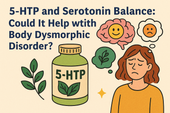
5-HTP and Serotonin Balance: Could It Help with Body Dysmorphic Disorder?
Anxiety can feel like a storm inside the mind—restless, overwhelming, and hard to control. In people with Body Dysmorphic Disorder (BDD), anxiety often fuels obsessive thoughts and self-criticism, creating a painful cycle of worry and self-doubt. This article explores the biological roots of anxiety, the role of neurotransmitters like serotonin and GABA, and how natural strategies such as mindfulness, supplements, and nervous system regulation can restore calm and mental clarity.
-
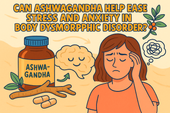
Can Ashwagandha Help Ease Stress and Anxiety in Body Dysmorphic Disorder?
Neurotransmitters like serotonin, dopamine, GABA, and acetylcholine are the chemical messengers that shape how we think, feel, and react to stress. In Body Dysmorphic Disorder (BDD), imbalances in these neurotransmitters can amplify anxiety, obsessive thinking, and emotional distress. This article explores how restoring healthy brain chemistry through nutrition, supplements, and mindfulness can help bring clarity, calm, and emotional stability.
-
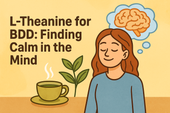
L-Theanine for BDD: Finding Calm in the Mind
Neurochemistry plays a central role in how we think, feel, and see ourselves. For those living with Body Dysmorphic Disorder (BDD), imbalances in neurotransmitters like serotonin, dopamine, and GABA can intensify anxiety, obsessive thoughts, and emotional distress. This article explores how regulating brain chemistry through supplements, mindfulness, and lifestyle changes can bring the nervous system back into harmony and restore inner calm.
-

Omega-3 Fatty Acids and Body Image Disorders: Supporting Emotional Health
Omega-3 fatty acids do far more than support heart health—they nourish the brain, stabilize mood, and may ease the emotional turbulence tied to body image disorders like BDD. This in-depth article explores how omega-3s regulate serotonin, dopamine, and inflammation, helping individuals reduce obsessive thoughts and rebuild self-acceptance. It also connects nutrition to therapy, mindfulness, and nervous system balance for holistic emotional healing.
-
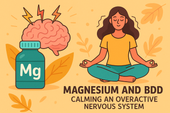
Magnesium and BDD: Calming an Overactive Nervous System
Magnesium plays a crucial role in calming an overactive nervous system—something people with Body Dysmorphic Disorder (BDD) struggle with daily. This article explores how magnesium supports relaxation, emotional regulation, and stress reduction while diving into the science behind its connection to brain chemistry. It also examines how combining magnesium supplementation with therapy and breathwork can help rebalance the body’s stress response, reduce obsessive thought patterns, and promote lasting nervous system calm.
-
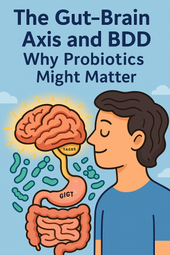
The Gut-Brain Axis and BDD: Why Probiotics Might Matter
The gut and brain are constantly in conversation — and that dialogue may shape how you experience Body Dysmorphic Disorder. By nurturing your microbiome with probiotics, prebiotics, and gut-healing nutrients, you can help rebalance serotonin, calm anxiety, and restore emotional stability from within 🧠🦠.
-
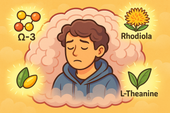
Brain Fog and Body Dysmorphic Disorder: Can Nootropic Supplements Help?
Brain fog often accompanies Body Dysmorphic Disorder, clouding focus and deepening emotional fatigue. Nootropic supplements like L-theanine, Rhodiola, and CoQ10 can help restore mental clarity, balance neurotransmitters, and bring calm energy back to the mind 🌿🧠.
-
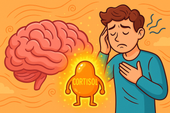
How Stress Hormones Like Cortisol May Worsen Body Dysmorphic Disorder
Chronic stress floods the brain with cortisol — the hormone that keeps you on high alert. In Body Dysmorphic Disorder, this chemical overdrive fuels anxiety, distorts self-image, and traps the body in survival mode. Calming cortisol helps restore both peace and perspective 🌿🧠.
-
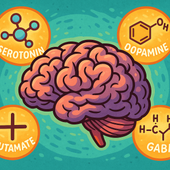
The Role of Neurotransmitters in BDD—and How Supplements May Help
Neurotransmitters like serotonin, dopamine, glutamate, and GABA shape how people with Body Dysmorphic Disorder perceive themselves. When these brain messengers fall out of balance, perception distorts — but targeted supplements can help restore calm, focus, and emotional regulation 🧠🌿.
-

What Is Body Dysmorphic Disorder? A Deeper Look at the Mind-Body Connection
Body Dysmorphic Disorder (BDD) isn’t just about appearance — it’s about perception. When brain chemistry, trauma, and stress distort self-image, the mind begins to see flaws that aren’t truly there. Healing starts by calming the nervous system and reconnecting mind and body 🪞🧠.
-

Keeping Calm in Competitive Sports: How to Train Your Mind, Body, and Chemistry for Peak Performance
Competitive pressure can overwhelm even the strongest athletes — but calm is trainable. By combining supplements like magnesium, L-theanine, and adaptogens with breathwork and mindset training, you can stay focused, balanced, and in control under any level of stress 🧠🏅.
-
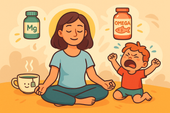
Supplements for Parents Facing Toddler Tantrums: Staying Calm When Little Emotions Run Wild
Toddler tantrums can drain even the most loving parent — but your calm is powerful. With the right supplements like magnesium, L-theanine, and ashwagandha supporting your nervous system, you can stay patient, grounded, and kind, even when emotions run high 🧸🌿.
-

Workplace Stress and Anger Management Support
Workplace stress can quickly turn into frustration — but calm is a skill you can train. By combining supplements like magnesium, L-theanine, and adaptogens with breathwork and mindset tools, you can stay focused, patient, and emotionally grounded no matter how intense the office gets 💼🌿.
-

How to Stay Patient With Family During Stressful Holidays
Holiday gatherings can stir up old stress and test your patience — but calm is possible. With nervous system support from magnesium, L-theanine, and adaptogens, plus mindful breathing and clear boundaries, you can stay centered, kind, and grounded even when family chaos unfolds 🎄💞.
-

Supplements to Keep Calm During Traffic Jams
Getting stuck in traffic doesn’t have to ruin your mood. With calming supplements like magnesium, L-theanine, and ashwagandha, you can train your body to stay relaxed and focused behind the wheel — turning gridlock into a moment of grounded patience 🚗🌿.
-
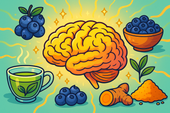
The Role of Antioxidants in Healing Brain Stress from Dissociation
Antioxidants protect the brain from the oxidative stress caused by trauma and dissociation. By neutralizing free radicals and supporting mitochondrial recovery, they help restore clarity, focus, and emotional balance — allowing the mind to heal at the cellular level 🌿🧠.
-
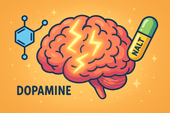
N-Acetyl L-Tyrosine (NALT) for Supporting Mental Clarity
N-Acetyl L-Tyrosine (NALT) fuels dopamine production — the neurotransmitter of focus and motivation. By supporting brain chemistry during stress, NALT helps restore mental clarity, energy, and alertness, making it easier to think clearly and feel present again ⚡🧠.
-

How Ginseng May Improve Focus and Energy in Dissociation
Ginseng helps combat the mental fatigue and fog that often come with dissociation. By supporting mitochondrial energy, balancing neurotransmitters, and regulating cortisol, it gently restores focus, motivation, and emotional presence — helping the mind reconnect with clarity and strength 🌿⚡.
-
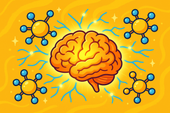
Phosphatidylserine and Dissociation: Supporting Cognitive Function
Phosphatidylserine helps calm the stress response by balancing cortisol, the body’s primary stress hormone. By lowering cortisol spikes, it protects memory, focus, and emotional stability — restoring clarity and mental presence for those struggling with dissociation 🧠🌿.
-
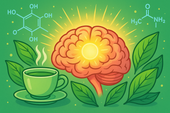
Can Green Tea Extract Help with Dissociative Brain Fog?
Green tea extract may help lift dissociative brain fog by supporting neurotransmitter balance, reducing inflammation, and enhancing energy at the cellular level. With its key compounds EGCG and L-theanine, it promotes calm focus, clarity, and emotional presence — helping you feel more alert and grounded 🍵🧠.
-
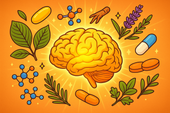
Building a Natural Supplement Stack for Dissociation Support
Building a supplement stack for dissociation means nourishing the brain and body back into communication. By supporting neurotransmitters, gut health, and energy balance through nutrients like magnesium, omega-3s, curcumin, and probiotics, you can help restore clarity, calm, and connection — one layer at a time 🌿🧠.
-
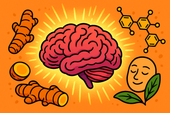
Curcumin for Inflammation and Mental Clarity in Dissociation
Curcumin, the golden compound in turmeric, does more than fight inflammation — it helps clear the mental fog often tied to dissociation. By calming neuroinflammation, balancing neurotransmitters, and supporting mitochondrial energy, curcumin can restore mental clarity, focus, and emotional presence 🌿🧠.
-
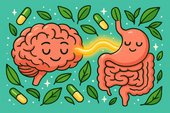
Probiotics and Dissociation: Exploring the Gut–Brain Axis
The gut–brain axis plays a vital role in emotional awareness and presence. When the microbiome is balanced, it supports serotonin production, vagus nerve activity, and calm focus. Probiotics help repair this connection — restoring safety, clarity, and the feeling of truly being in your body again 🌿🧠.
-
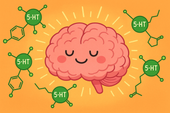
5-HTP for Dissociation: Supporting Serotonin and Emotional Stability
5-HTP helps bridge the gap between emotional numbness and stability by supporting serotonin production — the neurotransmitter that shapes mood, sleep, and sensory awareness. For people experiencing dissociation, 5-HTP may gently restore connection, presence, and emotional balance from the inside out 🌿🧠.

















































